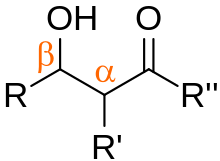Our website is made possible by displaying online advertisements to our visitors.
Please consider supporting us by disabling your ad blocker.
Aldol

In organic chemistry, an aldol is a structure consisting of a hydroxy group (-OH) two carbons away from either an aldehyde or a ketone. The name combines the suffix 'ol' from the alcohol and the prefix depending on the carbonyl group, either 'ald' for an aldehyde, or 'ket' for a ketone, in which case it referred to as a 'ketol'. An aldol may also use the term β-hydroxy aldehyde (or β-hydroxy ketone for a ketol). The term "aldol" may refer to 3-hydroxybutanal.[1][2]
Aldols are the product of a carbon-carbon bond-formation reaction, giving them wide applicability as a precursor for a variety of other compounds.
- ^ Kohlpainter, Christian; Schulte, Markus; Falbe, Jürgen; Lappe, Peter; Weber, Jürgen; Frey, Guido D. (15 January 2013). "Aldehydes, Aliphatic". Ullmann's Encyclopedia of Industrial Chemistry (7). doi:10.1002/14356007.a01_321.pub3. ISBN 9783527303854. Retrieved 1 April 2023 – via Wiley Online Library.
- ^ PubChem. "CID 21282929". National Center for Biotechnology Information. Retrieved 2023-04-15.
Previous Page Next Page


